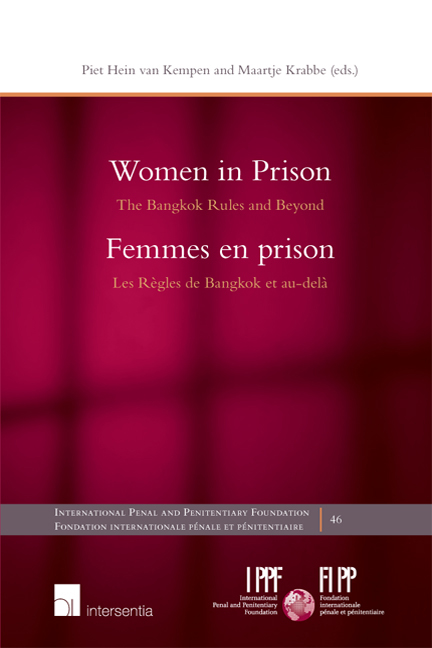Book contents
- Frontmatter
- Foreword
- Avant-propos
- Acknowledgements
- Remerciements
- Contents
- Part I Introductory Synthesis and Analyses: 1ÈRE Partie Synthèse ET Analyses Introductives
- Part II Themes: 2ÈME Partie Thèmes
- Part III National Reports: 3ÈME Partie Rapports Nationaux
- Women in prison in Argentina
- Women in prison in Australia
- Women in prison in Austria
- Women in prison in Brazil
- Women in prison in England and Wales
- Women in prison in Finland
- Femmes en prison en France
- Women in prison in Germany
- Women in prison in Greece
- Women in prison in Ireland
- Femmes en prison en Italie
- Women in prison in the Netherlands
- Women in prison in New Zealand
- Women in prison in Poland
- Women in prison in Portugal
- Women in prison in Russia
- Women in prison in South Africa
- Women in prison in Spain: their criminological and social invisibility
- Femmes en prison en Suisse: la situation des femmes prévenues et condamnées
- Women in prison in Taiwan
- Women in prison in Thailand: implementation of the UN Bangkok Rules in the Thai criminal justice system
- Femmes en prison en Turquie
- Women in prison in the USA
- Appendix The Bangkok Rules: Annexe Règles De Bangkok
- The International Penal and Penitentiary Foundation: History and Purpose
Women in prison in the Netherlands
from Part III - National Reports: 3ÈME Partie Rapports Nationaux
Published online by Cambridge University Press: 25 September 2018
- Frontmatter
- Foreword
- Avant-propos
- Acknowledgements
- Remerciements
- Contents
- Part I Introductory Synthesis and Analyses: 1ÈRE Partie Synthèse ET Analyses Introductives
- Part II Themes: 2ÈME Partie Thèmes
- Part III National Reports: 3ÈME Partie Rapports Nationaux
- Women in prison in Argentina
- Women in prison in Australia
- Women in prison in Austria
- Women in prison in Brazil
- Women in prison in England and Wales
- Women in prison in Finland
- Femmes en prison en France
- Women in prison in Germany
- Women in prison in Greece
- Women in prison in Ireland
- Femmes en prison en Italie
- Women in prison in the Netherlands
- Women in prison in New Zealand
- Women in prison in Poland
- Women in prison in Portugal
- Women in prison in Russia
- Women in prison in South Africa
- Women in prison in Spain: their criminological and social invisibility
- Femmes en prison en Suisse: la situation des femmes prévenues et condamnées
- Women in prison in Taiwan
- Women in prison in Thailand: implementation of the UN Bangkok Rules in the Thai criminal justice system
- Femmes en prison en Turquie
- Women in prison in the USA
- Appendix The Bangkok Rules: Annexe Règles De Bangkok
- The International Penal and Penitentiary Foundation: History and Purpose
Summary
INTRODUCTION
PRISONS FOR WOMEN
A decade ago (2004) there were five prisons for women in the Netherlands with a capacity of around 900 cells. At present (2014) there are three prisons for women with a capacity of around 500 cells. The three prisons are called Ter Peel, Nieuwersluis and Zwolle. Ter Peel is both a remand house (125 places) and a prison with normal security (133 places), minimal security (9 places) and limited security (7 places). In this prison a mother-child unit exists with capacity for five mothers with young children. Furthermore, there is a bed-and-breakfast facility where children up to 16 years of age can spend a night and stay with their mothers at the weekend. Nieuwersluis is also both a remand house (154 places) and a prison with normal (48 places) and limited (18 places) security levels. In Nieuwersluis there is a mother-child unit for four women. Zwolle is a remand house (100 places) with special units for women with psychiatric problems (20 places) and units for persistent offenders (32 places).
Women in prison form around 6% of the total prison population in the Netherlands. In times when the total prison population was substantially smaller than nowadays, the effect was that the prison facilities and provisions for female prisoners were less than for male prisoners. There was almost no possibility for differentiation among female prisoners: there were no prisons tailored for women, and no open prisons existed for women. The situation today is different. Facilities and provisions are equal for both male and female prisoners, although some minor differences still exist, e.g. libraries and gyms in women's prisons are smaller than in men's prisons.
THE BANGKOK RULES
In this chapter we deal with some gender-specific characteristics and needs of women in prison against the background of the UN Rules for the Treatment of Women Prisoners and Non-custodial Measures for Women Offenders, the so-called Bangkok Rules, unanimously adopted by the General Assembly of the United Nations in December 2010. The Bangkok Rules were an initiative by the Thai Government and inspired by the Project on Enhancing Lives of Female Inmates (ELFI) that was initiated by HRH Princess Bajrakitiyabha Mahidol of Thailand.
The rationale of the Bangkok Rules is twofold:
- prisons are designed predominantly by and for men; and
- Type
- Chapter
- Information
- Women in PrisonThe Bangkok Rules and Beyond, pp. 539 - 562Publisher: IntersentiaPrint publication year: 2017



